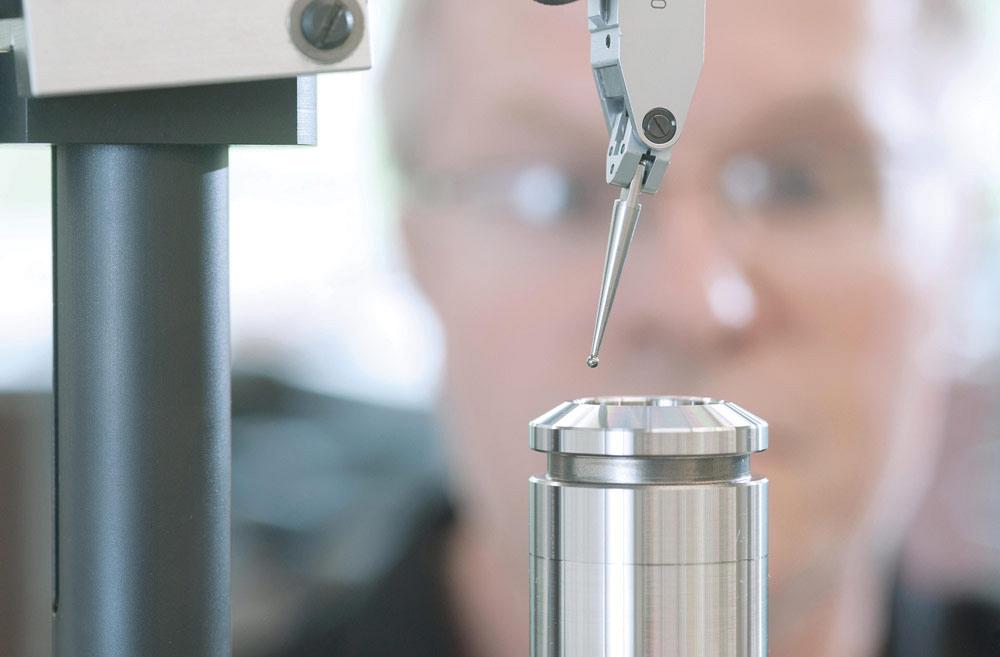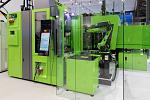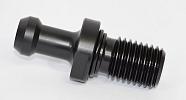Associate Editor
- FMA
- The Fabricator
- FABTECH
- Canadian Metalworking
8 extended-reach toolholder tips
Experts weigh in on how to best take advantage of extended-reach toolholders in 5-axis applications
- By Lindsay Luminoso
- June 21, 2021
- Article
- Metalworking

It makes sense to operate in the 5,000-RPM or less range with this type of toolholder. But you also want to slowly increase the speed to find the optimal speed limit for the toolholder length. Rego-Fix
The ability to produce complex components with unique shapes and features is one of the hallmarks of 5-axis machining. However, the ability to reach different angles or locations on the part, like deep pockets, can be difficult. This is where an extended-reach toolholder comes into play.
Standard toolholders that are in the 200-mm or smaller range tend to offer good rigidity. These toolholders are not that far out from the spindle face and enable aggressive machining. Extended-reach toolholders generally are longer than 300 mm and tend to be quite slim, presenting several challenges for accuracy and quality.
Whether a shop has a range of toolholders with different extensions to get the reach they want or has a true extended-length option, the experts weigh in on the best advice to increase toolholder performance, regardless of situation or application.
1. Understand How the Cutting Tool Affects the Toolholder
"The optimal toolholder length is one that will allow you to use standard tooling and standard cutting tools," said Brendt Holden, president, Haimer USA, Villa Park, Ill. "If you can use standard cutting tools in combination with the one-time cost of an extended-toolholder assembly, that’s a very important consideration, and it’s probably the first thing I would examine."
The shorter and stubbier the toolholder, the more rigid the connection. However, the toolholder should be as small as possible yet long enough to perform the desired machining operations while accommodating a standard cutting tool.
"Some shops believe that a longer toolholder with a shorter cutting tool is the best option," said David McHenry, engineering and technical manager, Rego-Fix Tool Corp., Whitestown, Ind. "In many cases this is true. But carbide, in general, is more rigid than a toolholder. There comes a point—around a 0.75-in.-dia. shank—where a longer cutting tool and shorter toolholder can provide a more rigid setup."
Beyond the cutting tool-toolholder optimal length aspect, the flute geometry of the cutting tool can also affect the quality of the cut.
"Every time the flute geometry makes contact with the part, it sends vibrations back up through the toolholder," said McHenry. "Take aluminum, for example. With a 2-flute end mill, it has a lot of impact, and each tooth is doing a lot of work. With a 3-flute option, the third tooth takes on some of the impact, lessening it for the other teeth, leading to decreased vibration."
When shops need to use an extended-reach toolholder, choosing a multiflute cutting tool with a higher helix will limit the impact, lessen vibration, and lead to smoother cutting and better surface quality.
2. Cut With a Single Setup
With 5-axis applications shops may think that they need to perform multiple fixturing to reach various features and areas of a part.

Extended-reach toolholders generally are longer than 300 mm and tend to be quite slim, presenting several challenges for achieving accuracy and quality. Haimer
"Getting parts done with one fixturing is really important to make the machine as productive as it can be," said Alan Miller, engineering and product manager, BIG KAISER Precision Tooling Inc., Hoffman Estates, Ill. "Applications may include areas where the machine needs to reach into small or deep locations like pockets while not interfering with other components and features of the part. This is where extended-reach toolholders really shine."
Double fixturing or reorienting the part during the machining process not only takes time, but can also present inaccuracy issues. Alignment is important, and sometimes it can be difficult and time-consuming to ensure the part is accurately and appropriately fixtured. One setup eliminates these variables and allows for the operator to machine all in one shot.
3. Maintain Balance Throughout the Toolholder’s Life
Balance of the assembly is always important but especially so in extended applications.
"It is always recommended to make sure that that assembly is balanced in two planes," said Holden. "You have to measure two locations on the length of the toolholder to take out any unbalance in the assembly. There’s a procedure involved with that, and you want to make sure that the procedure is available on that specific toolholder assembly and is easy to use in conjunction with the balancing machine. If you don’t, you end up with sort of a whipping effect at the edge and at the end and runout. Balance is so important."
It’s not enough to assume the assembly is balanced, even if it was factory-balanced. Factory balancing is a good start, but it’s equally important to ensure that balance is maintained throughout the process and for the life of the toolholder.
An unbalanced tool assembly can negatively affect runout, which could lead to bad conditions for proper surface finish, part tolerancing, and tool life.
"An in-house balancing machine of your own is a good start," said Holden. "That way you can check the balance as you change the cutting tools in and out over time."
Miller added that more industry and application-specific toolholder balance standards recently have been recognized. The new standards take into account different applications, whether it’s roughing or finishing, and what lengths are reasonable to balance these tools.
"Instead of having an infinite floor all the way down to zero, this new standard has a minimum balance value, where no matter what speed you balance this tool, it’s going to get to a certain level and any additional balancing isn’t going to give a benefit," said Miller. "As far as the new balanced standard is concerned, as long as the toolholders fall within that standard, there’s no reason to be concerned about balance."
4. Explore Dampening Options
The best practice when you get into extreme length-to-diameter ratios is to look for a toolholder that includes a dampening system to absorb the vibrations. Many different options are available, including inserting a carbide bar or rod into the assembly, hydraulic chucks, or a mechanical anti-vibration system.
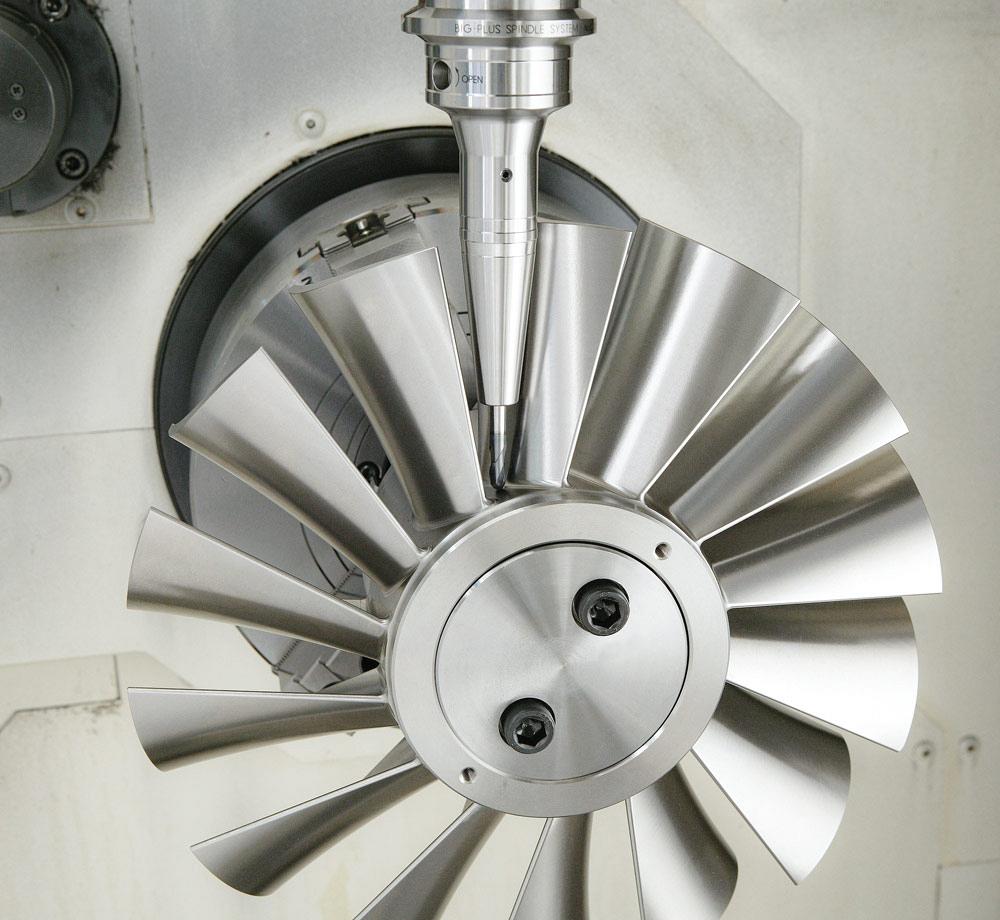
Extended-reach toolholders are able to reach into small or deep locations like pockets without interfering with other components and features of the part. Big Kaiser
"When you get into extended lengths, the assembly can act like a tuning fork," said McHenry. "All that vibration wants to just go through that superlong holder and back into the part, which is bad for surface finish and tool life. A dampening system will absorb that vibration."
5. Eliminate Runout
It’s important to make sure that you have very little runout at the cutting edge and that it is held tightly. This is where some advanced technology can help. Some manual toolholders, on which the extensions are added by screws, may not have the strength to hold the runout.
"Runout can be addressed by using modern technologies to give you that extended reach, whether its shrink-fit or another technology," said Holden. "You just need to make sure that it has the strength to hold the runout, while offering balance and rigidity to properly machine the part."
McHenry added that with the extended reach any total indicated runout (TIR) can create whip of the toolholder and deflection, and this is where cutting parameters can really help eliminate any runout issues.
6. Make Lighter Cuts
With extended-reach toolholding, you are no longer going for aggressive cuts.
"You’re going for lighter cuts," said McHenry. "It’s going to take more cutting time because the toolholder and cutting tool are so far out that the rigidity of the system just isn’t able to handle it at an aggressive pace."
7. Slow Everything Down
Vibration is a common issue with this type of toolholder and application, and the best way to fight against it and chatter is to slow down the cutting speed.
"Don’t just slow down the spindle speed," said Miller. "You will want to continue to back down the speed.
However, as you go slower and slower, that can affect tool life, and the machine is really not running in optimal conditions. So, it’s important to recognize that the resonance frequency of this assembly as a wave and sometimes going the opposite direction to get your cutter into a lobe of stability means increasing speed a little bit, rather than just dropping speed every time."
Trying minor speed adjustments to ±10 per cent will help get the tool out of that specific wave pattern that tends to cause vibration.
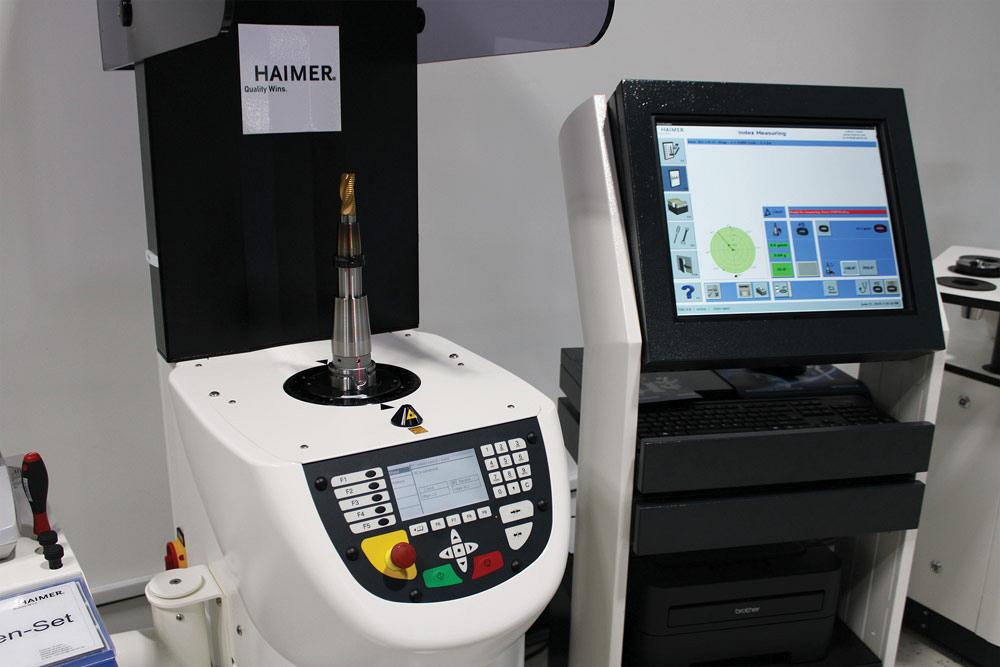
An unbalanced tool assembly can negatively affect runout, which could lead to bad conditions for proper surface finish, part tolerancing, and tool life. An in-house balancing machine can help ensure balance is maintained throughout the life of the toolholder. Haimer
McHenry suggests that it makes sense to operate in the 5,000-RPM or less range with this type of toolholder. He added that slowing everything down results in a decrease in chip load and surface footage. But you also want to slowly increase the speed to find the optimal speed limit for the toolholder length. A 300-mm toolholder will require one set of parameters, which will not be the same for a 600-mm holder.
8. Keep the Toolholder Clean
Cleanliness is king, and it’s not just cleanliness of the toolholder itself that is necessary. You want to make sure that the machine is in good working order and that the spindle, tool shank, tapers, and holder all are kept clean and free of debris.
"No matter what style of toolholder or assembly, cleanliness is always the best practice for maintaining runout accuracy and repeatability of the process," said Holden. "You also want to make sure that any machine tool interface is well taken care of."
The experts agree that ensuring toolholder cleanliness is crucial for success, especially with certain types of extended-reach systems, and for necessary gripping power. In a production environment it takes extra time to perform these extra steps, but they are the kinds of things that will extend toolholder life and give you that quality cut.
Associate Editor Lindsay Luminoso can be reached at lluminoso@canadianmetalworking.com.
BIG KAISER Precision Tooling, www.bigkaiser.com
Haimer, www.haimer.com
Rego-Fix, www.rego-fix.com
About the Author

Lindsay Luminoso
1154 Warden Avenue
Toronto, M1R 0A1 Canada
Lindsay Luminoso, associate editor, contributes to both Canadian Metalworking and Canadian Fabricating & Welding. She worked as an associate editor/web editor, at Canadian Metalworking from 2014-2016 and was most recently an associate editor at Design Engineering.
Luminoso has a bachelor of arts from Carleton University, a bachelor of education from Ottawa University, and a graduate certificate in book, magazine, and digital publishing from Centennial College.
Related Companies
subscribe now


Keep up to date with the latest news, events, and technology for all things metal from our pair of monthly magazines written specifically for Canadian manufacturers!
Start Your Free Subscription- Industry Events
MME Saskatoon
- May 28, 2024
- Saskatoon, SK Canada
CME's Health & Safety Symposium for Manufacturers
- May 29, 2024
- Mississauga, ON Canada
DiPaolo Machine Tools Open House 2024
- June 4 - 5, 2024
- Mississauga, ON Canada
FABTECH Canada
- June 11 - 13, 2024
- Toronto, ON Canada
Zoller Open House & Technology Days 2024
- June 12 - 13, 2024
- Ann Arbor, MI













